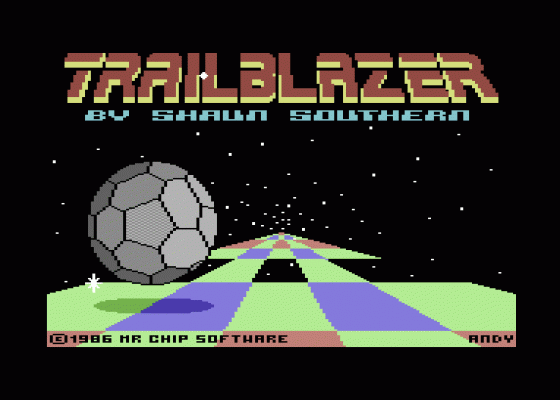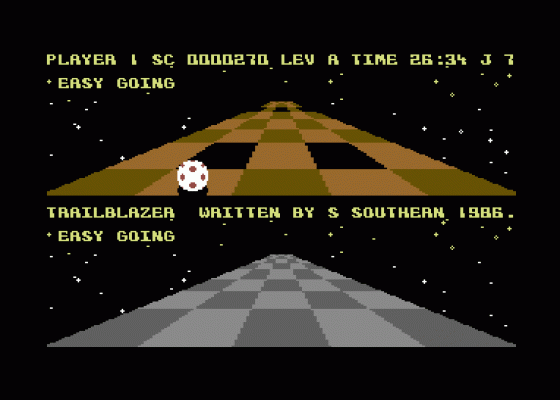
Computer Gamer
 1st November 1986
1st November 1986
Categories: Review: Software
Publisher: Gremlin
Machine: Commodore 64/128
Published in Computer Gamer #20
Will Gremlin blaze a trail to the top of the charts? We check out their latest brainchild.
Trailblazer
Every now and then, a game comes along that is so simple in concept and yet so infuriatingly difficult to play that it develops a cult following. Trailblazer will prove to be such a game.
Imagine a long trail of coloured squares suspended in the cosmos, the chequered path seeming to stretch forever beyond its own horizon. Next, imagine an intergalactic football bouncing along this route and you have the basic idea of Trailblazer.
The rules are simple - complete each track as quickly as possible and don't fall in too many black holes!

The game has several variants. You can test out one of the 21 courses to see what devious traps await you or you can play against the computer or a human opponent but the elite game is the arcade variation for one or two players against the clock.
Each square of the patchwork has a role to play in the game because of its effect on the ball. Seven special colours are used: green, white, red, cyan, blue, purple and black.
If the ball hits a green square it will go faster until a maximum speed is reached but touching a white square in the arcade variant will increase this to a neck-breaking warp speed. In the other variations the white squares merely cause the ball to bounce.

Red squares have the effect of slowing the ball down and often these squares come on large blocks taking up the full five square width of the track at a length of two or three rows deep. By limiting the speed, these also deaden the bounce of the ball.
The colour cyan is a dangerous one to meet because these squares reverse the left-right controls of the joystick. In the heat of a race, the large expanses of cyan track can really take you by surprise, switching your mind into a mirror-image response mode.
Blue is one of the most crucial colours and generally these appear near giant chasms in the track. Hit a blue square at speed and the ball will leap into the air bridging several rows of squares or black spaces.

Picking up speed by passing over the green squares will be to no avail if your ball meets a purple square. Now the ball stops dead and springs back towards the screen. These squares often form slalom sections which must be negotiated by swerving left and right or by bouncing across the offending square.
Black squares hold the key to the game. These are holes in the track and appear frequently in the path of the ball both as slalom sections and as long jumps preceded by blue squares which help you to leap across these voids. Falling into a black hole has the effect of delaying your progress for several crucial seconds and cancelling the warp mode if you've previously rolled over a white square.
All sections start in a neutral grey zone and the screen is split to show each player's ball. Player one uses the top part of the screen and player two, or the computer, is shown in the lower section.
In the practice and two-player games the course consists of three sections which can be selected from the menu screen. If you really want to master a difficult section, it can be selected three times but any combination of three from the full 21 can be used.
A joystick is not essential for the second player because there is a specially designated keyboard control system, which some may prefer. By selecting one of the two player games, a solo player can try out the keys without jeopardising their chance of success but you may have to wait for the ball you'd normally be controlling to 'die'.
If you select the computer as your opponent, beware of its slick methods of running along the edge of black holes. I've tried and failed to emulate this and have come to the conclusion that the computer cheats! This does not mean that it is unbeatable but it will certainly give you a roll for your money.
It is essential to practice each course before trying to play the arcade game because of the tight time limits set. As long as you keep to schedule, each track cycles round in alphabetical order in groups of three. At the end of each group you enter a very difficult but rewarding bonus screen.
To gain the high bonus score you have to watch the screen very carefully. The ball appears and bounces on three of the squares on a portion of track in the foreground, then it's your turn. As you move the joystick arrows appear at the top of the screen, select the ones which will lead the ball to the first square of the sequence and press fire, then to the second and so on until the pattern has been drawn. The maximum is reached if you get five correct answers and you move on to the next route with a fat score under your belt.
The time limit is very tight indeed, giving no time for deliberation. You're either right or wrong and if you're right you get a bonus and a new challenge. Each new sequence adds an extra move on to the previous sequence in this visual version of Simple Simon until you fail to get it right.
Each course has a name which often gives a clue to the main feature of that track. For example, Easy Going is the starter track, Woolly Jumper has lots of leaps, Change Lane Now and Get in Lane means switch about from left to right, and Meet the Cyan Zone can easily be guessed.
During my review session, the best arcade achievement was 43,300 for which I had to reach Zone G. No doubt you'll soon beat this, but it does give you something to go for.
The main aim of the arcade game is to hit those rare white zones and avoid the pitfalls while warping along the course. This is not very easy because the faster you go, the more blurred the whizzing track becomes. With a modicum of training and a lot of luck, a large part of the course can be skipped and, since time remaining adds a special bonus to your score, the highest scores are achieved this way. Even if you miss the warp square it is possible to complete the course, but only with a lot of skill and experience.
I said initially that this was a relatively simple concept, but I think you can see that there is a lot on offer in this game. Programmer Shaun Southern of Mr Chip Software has done a masterly job for Gremlin, especially when you consider that it was originally written for the C16. It's not often that a game successfully makes this transition to the C64 but this is an exceptional game. Not for a long time have I been so hooked and several times I've been forced to drag myself away from writing this review just to check on a few finer points of the game, you understand.
Although I've yet to see the Spectrum, C16, Amstrad, MSX and Atari versions of this game, I await them with great anticipation and, from what I saw at the PCW Show, I don't think I'll be disappointed. Well done Gremlin, this deserves to be the biggest blockbuster of 1986.
Other Reviews Of Trailblazer For The Commodore 64/128
Trailblazer (Gremlin)
Weird but wonderful split-screen racing game
Trailblazer (Gremlin)
A review by Ferdy Hamilton (Commodore User)



